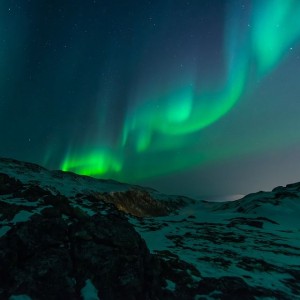Aurora Borealis

Valerie Assinewe,
Guest Blogger
This blog was written by guest blogger Valerie Assinewe.
The Aurora borealis, northern lights, is featured in this month’s calendar. As you watch this fascinating display in our night sky, you too may have asked yourself the following questions:
What causes this display?
The temperature above the surface of the sun is millions of degrees Celsius. At this temperature, collisions between gas molecules are frequent and explosive. Free electrons and protons escape the sun’s atmosphere. The solar wind blows the particles outward throughout the solar system. About forty hours later, the particles reach earth where the earth’s magnetic field deflects most of the charged particles. As the earth’s magnetic field is weaker at either pole, some particles enter the earth’s atmosphere and collide with gas particles. These collisions emit light that we perceive as dancing lights: the Aurora borealis in the north and the Aurora australis in the south.
Why does it appear as a wall of lights?
 Auroras usually occur in a ring ~3000 km across centered on the magnetic pole. Solar flares can cause the rings to expand bringing the aurora to lower altitudes. The lights of the aurora generally extend 100-400 km above the earth’s surface. Seen from the ground, the auroras can be a static band of light or when a solar flare is strong, you can see the aurora as a dancing curtain of ever-changing light.
Auroras usually occur in a ring ~3000 km across centered on the magnetic pole. Solar flares can cause the rings to expand bringing the aurora to lower altitudes. The lights of the aurora generally extend 100-400 km above the earth’s surface. Seen from the ground, the auroras can be a static band of light or when a solar flare is strong, you can see the aurora as a dancing curtain of ever-changing light.
Can it do any other colour than green?
After travelling ~150 million km from our sun, particles that pass through the Earth’s magnetic shield mingle with atoms and molecules of oxygen, nitrogen and other elements in our atmosphere. Typically, when the particles collide with oxygen they produce green and yellow colours. Interactions with nitrogen produce red, violet and occasionally blue colours. The type of collision makes a difference to the colors that appear in the sky: atomic nitrogen causes blue displays, while molecular nitrogen results in purple. Altitude also affects colours: green lights typically appear in areas up to 241 km high, red above 240 km, blue usually appears up to 97 km, and purple and violet above 97 km.
Where can we see the Auroras?
In Canada, the northern parts of the country are the best place to view the Aurora borealis. In addition, winter is usually the best time to see them because of the longer period of darkness, lower levels of light pollution and the clear, crisp air. Up to two days after sunspot, activity provides the best displays.
While northern Canada is the best place to view northern lights, other places across Canada with the right conditions may provide excellent viewing too. So, at that time get into some warm clothes, grab some hot chocolate, get away from the light pollution and enjoy this awesome display!




